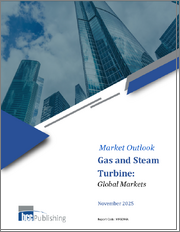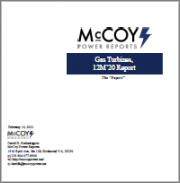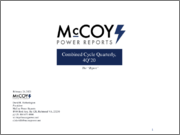
|
시장보고서
상품코드
1691711
세계의 단축 터빈 시장 - 산업규모, 점유율, 동향, 기회, 예측, 부문별, 유형별, 정격출력별, 최종사용자 산업별, 용도별, 지역별 부문, 경쟁(2020-2030년)Single Shaft Turbine Market - Global Industry Size, Share, Trends, Opportunity, and Forecast, Segmented, By Type, By Power Rating, By End-User Industry, By Application, By Region, By Competition, 2020-2030F |
||||||
단축 터빈 세계 시장 규모는 2024년에 32억 3,000만 달러로 평가되었으며, 예측 기간 중 CAGR은 5.54%를 나타낼 전망이며, 2030년에는 45억 달러에 달할 것으로 예측되고 있습니다.
단축 터빈 시장은 발전, 석유, 가스, 항공우주 및 산업 분야에서 널리 사용되는 단일 샤프트 구성을 특징으로 하는 터빈의 설계, 제조 및 배치에 초점을 맞춘 세계 산업을 다룹니다. 단축 터빈은 컴프레서, 터빈, 발전기 또는 기계 부하를 하나의 연속 샤프트에 통합한 단일 로터 어셈블리로 작동하여 에너지 변환 최적화, 운전 효율 향상, 기계 손실 감소를 실현합니다. 이 설계는 동기 성능, 열 효율 향상, 최소 유지 보수가 필요한 고출력 용도에 특히 유리합니다.
| 시장 개요 | |
|---|---|
| 예측 기간 | 2026-2030년 |
| 시장 규모 : 2024년 | 32억 3,000만 달러 |
| 시장 규모 : 2030년 | 45억 달러 |
| CAGR : 2025-2030년 | 5.54% |
| 급성장 부문 | 증기 터빈 |
| 최대 시장 | 북미 |
시장 성장 촉진요인
효율적인 발전 솔루션에 대한 수요 증가
주요 시장 과제
높은 초기 투자 및 설치 비용
주요 시장 동향
분산 에너지 시스템에서 일축 터빈 채택 확대
목차
제1장 개요
제2장 조사 방법
제3장 주요 요약
제4장 고객의 목소리
제5장 세계의 단축 터빈 시장 전망
- 시장 규모와 예측
- 금액별
- 시장 점유율 및 예측
- 유형별(가스 터빈, 증기 터빈, 수력 터빈, 풍력 터빈, 기타)
- 정격 출력별(50MW 이하, 50-100MW, 100-300MW, 300-500MW, 500-700MW, 700MW 이상, 기타)
- 최종 사용자 산업별(발전, 석유 및 가스, 공업, 항공, 해양, 기타)
- 용도별(발전소, 석유 및 가스 산업, 화학 산업, 철강 산업, 광업, 항공 산업, 해양 산업)
- 지역별
- 기업별(2024)
- 시장 맵
제6장 북미의 단축 터빈 시장 전망
- 시장 규모와 예측
- 시장 점유율 및 예측
- 북미 : 국가별 분석
- 캐나다
- 멕시코
제7장 유럽의 단축 터빈 시장 전망
- 시장 규모와 예측
- 시장 점유율 및 예측
- 유럽 : 국가별 분석
- 영국
- 이탈리아
- 프랑스
- 스페인
제8장 아시아태평양의 단축 터빈 시장 전망
- 시장 규모와 예측
- 시장 점유율 및 예측
- 아시아태평양 : 국가별 분석
- 인도
- 일본
- 한국
- 호주
제9장 남미의 단축 터빈 시장 전망
- 시장 규모와 예측
- 시장 점유율 및 예측
- 남미 : 국가별 분석
- 아르헨티나
- 콜롬비아
제10장 중동 및 아프리카의 단축 터빈 시장 전망
- 시장 규모와 예측
- 시장 점유율 및 예측
- 중동 및 아프리카 : 국가별 분석
- 사우디아라비아
- 아랍에미리트(UAE)
- 쿠웨이트
- 터키
제11장 시장 역학
- 성장 촉진요인
- 과제
제12장 시장 동향과 발전
- 합병과 인수(해당하는 경우)
- 제품 발매(해당하는 경우)
- 최근 동향
제13장 기업 프로파일
- Toshiba Corporation
- Harbin Electric Corporation
- Bharat Heavy Electricals Limited
- Hitachi Limited
- Kirloskar Brothers Limited
- Ansaldo Energia SpA
- ANDRITZ AG
- Siemens AG
- GE Vernova Group
- Voith GmbH & Co. KGaA
제14장 전략적 제안
제15장 기업 소개와 면책사항
SHW 25.04.15Global Single Shaft Turbine Market was valued at USD 3.23 billion in 2024 and is expected to reach USD 4.50 billion by 2030 with a CAGR of 5.54% during the forecast period. The Single Shaft Turbine Market encompasses the global industry focused on the design, manufacturing, and deployment of turbines featuring a single shaft configuration, widely utilized across power generation, oil & gas, aerospace, and industrial applications. A single shaft turbine operates with a single rotor assembly, integrating the compressor, turbine, and generator or mechanical load on a single continuous shaft, ensuring optimized energy conversion, enhanced operational efficiency, and reduced mechanical losses. This design is particularly advantageous in high-power applications that demand synchronized performance, improved thermal efficiency, and minimal maintenance.
| Market Overview | |
|---|---|
| Forecast Period | 2026-2030 |
| Market Size 2024 | USD 3.23 Billion |
| Market Size 2030 | USD 4.50 Billion |
| CAGR 2025-2030 | 5.54% |
| Fastest Growing Segment | Steam Turbines |
| Largest Market | North America |
Key Market Drivers
Rising Demand for Efficient Power Generation Solutions
The increasing global demand for efficient power generation solutions is a major driver of the single shaft turbine market. With the growing focus on optimizing energy production, industries are shifting toward high-performance turbine systems that offer enhanced efficiency, reduced emissions, and lower operational costs. Single shaft turbines are particularly favored in power plants, oil & gas facilities, and industrial applications due to their ability to deliver higher power output with minimal energy losses. Their streamlined design, which integrates the compressor, turbine, and generator on a single axis, allows for improved operational stability and reduced mechanical complexity, leading to lower maintenance costs. Governments and energy regulatory bodies are also emphasizing cleaner and more efficient energy generation, promoting the adoption of single shaft turbines.
Technological advancements, such as the incorporation of digital control systems and real-time monitoring, are further enhancing the performance and reliability of these turbines. With increasing investments in power infrastructure across regions like North America, Europe, and Asia-Pacific, the demand for single shaft turbines is expected to grow steadily. The market is also benefiting from the rise in combined cycle power plants, where single shaft turbines are used to optimize heat recovery, resulting in improved overall efficiency. As industries continue to prioritize energy efficiency and operational cost reduction, the single shaft turbine market is poised for significant growth. Combined-cycle gas turbine (CCGT) plants, known for their high efficiency, are expected to represent around 60% of new thermal power generation capacity by 2030, with efficiencies exceeding 60% in some advanced plants.
Key Market Challenges
High Initial Investment and Installation Costs
The single shaft turbine market faces a significant challenge due to the high initial investment and installation costs associated with these systems. Unlike multi-shaft turbine configurations, which offer modular flexibility, single shaft turbines require precise engineering and large-scale infrastructure to ensure operational efficiency. The capital-intensive nature of these turbines includes expenses related to design, procurement, manufacturing, transportation, and installation. Additionally, the requirement for specialized materials, such as high-strength alloys and advanced cooling systems, further escalates costs. Manufacturing precision is crucial to maintaining efficiency and reliability, necessitating advanced production facilities and skilled labor, which further adds to expenses.
Beyond procurement and manufacturing, installation complexity presents another cost-intensive hurdle. Single shaft turbines demand a specialized setup process, requiring precise alignment to ensure optimal performance and avoid operational inefficiencies. This necessitates expert engineering teams and specialized equipment, leading to higher labor and commissioning costs. Site preparation and infrastructure development also contribute to rising expenses, especially in remote or offshore locations where logistical challenges further complicate installation. For example, in power generation plants, these turbines often require custom-built foundations and enclosures, adding to project costs.
Key Market Trends
Growing Adoption of Single Shaft Turbines in Distributed Energy Systems
The increasing demand for efficient and decentralized power generation is driving the adoption of single shaft turbines in distributed energy systems. As industries and municipalities seek reliable, on-site power generation to reduce dependence on conventional grids, single shaft turbines are emerging as a preferred solution due to their high efficiency, compact design, and lower operational costs. These turbines are particularly well-suited for cogeneration and combined heat and power (CHP) applications, which improve overall energy utilization and reduce carbon footprints. Additionally, advancements in fuel flexibility allow single shaft turbines to operate on a variety of fuels, including natural gas, biogas, and hydrogen, aligning with the global shift toward cleaner energy sources.
Another key factor driving this trend is the rise of microgrids, which are gaining traction in both urban and remote areas to ensure a stable energy supply. Governments and utilities worldwide are supporting microgrid development through subsidies, incentives, and regulatory reforms, further fueling the demand for efficient power generation technologies such as single shaft turbines. Furthermore, technological innovations, including digital monitoring, automation, and predictive maintenance, are enhancing the reliability and longevity of these turbines, making them an attractive investment for businesses looking to improve their energy independence. As industries prioritize energy resilience and operational efficiency, the single shaft turbine market is poised for significant growth within the distributed energy sector.
Key Market Players
- Toshiba Corporation
- Harbin Electric Corporation
- Bharat Heavy Electricals Limited
- Hitachi Limited
- Kirloskar Brothers Limited
- Ansaldo Energia S.p.A.
- ANDRITZ AG
- Siemens AG
- GE Vernova Group
- Voith GmbH & Co. KGaA
Report Scope:
In this report, the Global Single Shaft Turbine Market has been segmented into the following categories, in addition to the industry trends which have also been detailed below:
Single Shaft Turbine Market, By Type:
- Gas Turbines
- Steam Turbines
- Hydraulic Turbines
- Wind Turbines
- Others
Single Shaft Turbine Market, By Power Rating:
- Up to 50 MW
- 50-100 MW
- 100-300 MW
- 300-500 MW
- 500-700 MW
- Above 700 MW
- Others
Single Shaft Turbine Market, By End-User Industry:
- Power Generation
- Oil & Gas
- Industrial
- Aviation
- Marine
- Others
Single Shaft Turbine Market, By Application:
- Power Plants
- Oil & Gas Industry
- Chemical Industry
- Steel Industry
- Mining Industry
- Aviation
- Marine
Single Shaft Turbine Market, By Region:
- North America
- United States
- Canada
- Mexico
- Europe
- France
- United Kingdom
- Italy
- Germany
- Spain
- Asia-Pacific
- China
- India
- Japan
- Australia
- South Korea
- South America
- Brazil
- Argentina
- Colombia
- Middle East & Africa
- South Africa
- Saudi Arabia
- UAE
- Kuwait
- Turkey
Competitive Landscape
Company Profiles: Detailed analysis of the major companies presents in the Global Single Shaft Turbine Market.
Available Customizations:
Global Single Shaft Turbine Market report with the given Market data, TechSci Research offers customizations according to a company's specific needs. The following customization options are available for the report:
Company Information
- Detailed analysis and profiling of additional Market players (up to five).
Table of Contents
1. Product Overview
- 1.1. Market Definition
- 1.2. Scope of the Market
- 1.2.1. Markets Covered
- 1.2.2. Years Considered for Study
- 1.3. Key Market Segmentations
2. Research Methodology
- 2.1. Objective of the Study
- 2.2. Baseline Methodology
- 2.3. Formulation of the Scope
- 2.4. Assumptions and Limitations
- 2.5. Sources of Research
- 2.5.1. Secondary Research
- 2.5.2. Primary Research
- 2.6. Approach for the Market Study
- 2.6.1. The Bottom-Up Approach
- 2.6.2. The Top-Down Approach
- 2.7. Methodology Followed for Calculation of Market Size & Market Shares
- 2.8. Forecasting Methodology
- 2.8.1. Data Triangulation & Validation
3. Executive Summary
- 3.1. Overview of the Market
- 3.2. Overview of Key Market Segmentations
- 3.3. Overview of Key Market Players
- 3.4. Overview of Key Regions/Countries
- 3.5. Overview of Market Drivers, Challenges, and Trends
4. Voice of Customer
5. Global Single Shaft Turbine Market Outlook
- 5.1. Market Size & Forecast
- 5.1.1. By Value
- 5.2. Market Share & Forecast
- 5.2.1. By Type (Gas Turbines, Steam Turbines, Hydraulic Turbines, Wind Turbines, and Others)
- 5.2.2. By Power Rating (Up to 50 MW, 50-100 MW, 100-300 MW, 300-500 MW, 500-700 MW, Above 700 MW, and Others)
- 5.2.3. By End-User Industry (Power Generation, Oil & Gas, Industrial, Aviation, Marine, and Others)
- 5.2.4. By Application (Power Plants, Oil & Gas Industry, Chemical Industry, Steel Industry, Mining Industry, Aviation, and Marine)
- 5.2.5. By Region
- 5.3. By Company (2024)
- 5.4. Market Map
6. North America Single Shaft Turbine Market Outlook
- 6.1. Market Size & Forecast
- 6.1.1. By Value
- 6.2. Market Share & Forecast
- 6.2.1. By Type
- 6.2.2. By Power Rating
- 6.2.3. By End-User Industry
- 6.2.4. By Application
- 6.2.5. By Country
- 6.3. North America: Country Analysis
- 6.3.1. United States Single Shaft Turbine Market Outlook
- 6.3.1.1. Market Size & Forecast
- 6.3.1.1.1. By Value
- 6.3.1.2. Market Share & Forecast
- 6.3.1.2.1. By Type
- 6.3.1.2.2. By Power Rating
- 6.3.1.2.3. By End-User Industry
- 6.3.1.2.4. By Application
- 6.3.1.1. Market Size & Forecast
- 6.3.2. Canada Single Shaft Turbine Market Outlook
- 6.3.2.1. Market Size & Forecast
- 6.3.2.1.1. By Value
- 6.3.2.2. Market Share & Forecast
- 6.3.2.2.1. By Type
- 6.3.2.2.2. By Power Rating
- 6.3.2.2.3. By End-User Industry
- 6.3.2.2.4. By Application
- 6.3.2.1. Market Size & Forecast
- 6.3.3. Mexico Single Shaft Turbine Market Outlook
- 6.3.3.1. Market Size & Forecast
- 6.3.3.1.1. By Value
- 6.3.3.2. Market Share & Forecast
- 6.3.3.2.1. By Type
- 6.3.3.2.2. By Power Rating
- 6.3.3.2.3. By End-User Industry
- 6.3.3.2.4. By Application
- 6.3.3.1. Market Size & Forecast
- 6.3.1. United States Single Shaft Turbine Market Outlook
7. Europe Single Shaft Turbine Market Outlook
- 7.1. Market Size & Forecast
- 7.1.1. By Value
- 7.2. Market Share & Forecast
- 7.2.1. By Type
- 7.2.2. By Power Rating
- 7.2.3. By End-User Industry
- 7.2.4. By Application
- 7.2.5. By Country
- 7.3. Europe: Country Analysis
- 7.3.1. Germany Single Shaft Turbine Market Outlook
- 7.3.1.1. Market Size & Forecast
- 7.3.1.1.1. By Value
- 7.3.1.2. Market Share & Forecast
- 7.3.1.2.1. By Type
- 7.3.1.2.2. By Power Rating
- 7.3.1.2.3. By End-User Industry
- 7.3.1.2.4. By Application
- 7.3.1.1. Market Size & Forecast
- 7.3.2. United Kingdom Single Shaft Turbine Market Outlook
- 7.3.2.1. Market Size & Forecast
- 7.3.2.1.1. By Value
- 7.3.2.2. Market Share & Forecast
- 7.3.2.2.1. By Type
- 7.3.2.2.2. By Power Rating
- 7.3.2.2.3. By End-User Industry
- 7.3.2.2.4. By Application
- 7.3.2.1. Market Size & Forecast
- 7.3.3. Italy Single Shaft Turbine Market Outlook
- 7.3.3.1. Market Size & Forecast
- 7.3.3.1.1. By Value
- 7.3.3.2. Market Share & Forecast
- 7.3.3.2.1. By Type
- 7.3.3.2.2. By Power Rating
- 7.3.3.2.3. By End-User Industry
- 7.3.3.2.4. By Application
- 7.3.3.1. Market Size & Forecast
- 7.3.4. France Single Shaft Turbine Market Outlook
- 7.3.4.1. Market Size & Forecast
- 7.3.4.1.1. By Value
- 7.3.4.2. Market Share & Forecast
- 7.3.4.2.1. By Type
- 7.3.4.2.2. By Power Rating
- 7.3.4.2.3. By End-User Industry
- 7.3.4.2.4. By Application
- 7.3.4.1. Market Size & Forecast
- 7.3.5. Spain Single Shaft Turbine Market Outlook
- 7.3.5.1. Market Size & Forecast
- 7.3.5.1.1. By Value
- 7.3.5.2. Market Share & Forecast
- 7.3.5.2.1. By Type
- 7.3.5.2.2. By Power Rating
- 7.3.5.2.3. By End-User Industry
- 7.3.5.2.4. By Application
- 7.3.5.1. Market Size & Forecast
- 7.3.1. Germany Single Shaft Turbine Market Outlook
8. Asia-Pacific Single Shaft Turbine Market Outlook
- 8.1. Market Size & Forecast
- 8.1.1. By Value
- 8.2. Market Share & Forecast
- 8.2.1. By Type
- 8.2.2. By Power Rating
- 8.2.3. By End-User Industry
- 8.2.4. By Application
- 8.2.5. By Country
- 8.3. Asia-Pacific: Country Analysis
- 8.3.1. China Single Shaft Turbine Market Outlook
- 8.3.1.1. Market Size & Forecast
- 8.3.1.1.1. By Value
- 8.3.1.2. Market Share & Forecast
- 8.3.1.2.1. By Type
- 8.3.1.2.2. By Power Rating
- 8.3.1.2.3. By End-User Industry
- 8.3.1.2.4. By Application
- 8.3.1.1. Market Size & Forecast
- 8.3.2. India Single Shaft Turbine Market Outlook
- 8.3.2.1. Market Size & Forecast
- 8.3.2.1.1. By Value
- 8.3.2.2. Market Share & Forecast
- 8.3.2.2.1. By Type
- 8.3.2.2.2. By Power Rating
- 8.3.2.2.3. By End-User Industry
- 8.3.2.2.4. By Application
- 8.3.2.1. Market Size & Forecast
- 8.3.3. Japan Single Shaft Turbine Market Outlook
- 8.3.3.1. Market Size & Forecast
- 8.3.3.1.1. By Value
- 8.3.3.2. Market Share & Forecast
- 8.3.3.2.1. By Type
- 8.3.3.2.2. By Power Rating
- 8.3.3.2.3. By End-User Industry
- 8.3.3.2.4. By Application
- 8.3.3.1. Market Size & Forecast
- 8.3.4. South Korea Single Shaft Turbine Market Outlook
- 8.3.4.1. Market Size & Forecast
- 8.3.4.1.1. By Value
- 8.3.4.2. Market Share & Forecast
- 8.3.4.2.1. By Type
- 8.3.4.2.2. By Power Rating
- 8.3.4.2.3. By End-User Industry
- 8.3.4.2.4. By Application
- 8.3.4.1. Market Size & Forecast
- 8.3.5. Australia Single Shaft Turbine Market Outlook
- 8.3.5.1. Market Size & Forecast
- 8.3.5.1.1. By Value
- 8.3.5.2. Market Share & Forecast
- 8.3.5.2.1. By Type
- 8.3.5.2.2. By Power Rating
- 8.3.5.2.3. By End-User Industry
- 8.3.5.2.4. By Application
- 8.3.5.1. Market Size & Forecast
- 8.3.1. China Single Shaft Turbine Market Outlook
9. South America Single Shaft Turbine Market Outlook
- 9.1. Market Size & Forecast
- 9.1.1. By Value
- 9.2. Market Share & Forecast
- 9.2.1. By Type
- 9.2.2. By Power Rating
- 9.2.3. By End-User Industry
- 9.2.4. By Application
- 9.2.5. By Country
- 9.3. South America: Country Analysis
- 9.3.1. Brazil Single Shaft Turbine Market Outlook
- 9.3.1.1. Market Size & Forecast
- 9.3.1.1.1. By Value
- 9.3.1.2. Market Share & Forecast
- 9.3.1.2.1. By Type
- 9.3.1.2.2. By Power Rating
- 9.3.1.2.3. By End-User Industry
- 9.3.1.2.4. By Application
- 9.3.1.1. Market Size & Forecast
- 9.3.2. Argentina Single Shaft Turbine Market Outlook
- 9.3.2.1. Market Size & Forecast
- 9.3.2.1.1. By Value
- 9.3.2.2. Market Share & Forecast
- 9.3.2.2.1. By Type
- 9.3.2.2.2. By Power Rating
- 9.3.2.2.3. By End-User Industry
- 9.3.2.2.4. By Application
- 9.3.2.1. Market Size & Forecast
- 9.3.3. Colombia Single Shaft Turbine Market Outlook
- 9.3.3.1. Market Size & Forecast
- 9.3.3.1.1. By Value
- 9.3.3.2. Market Share & Forecast
- 9.3.3.2.1. By Type
- 9.3.3.2.2. By Power Rating
- 9.3.3.2.3. By End-User Industry
- 9.3.3.2.4. By Application
- 9.3.3.1. Market Size & Forecast
- 9.3.1. Brazil Single Shaft Turbine Market Outlook
10. Middle East and Africa Single Shaft Turbine Market Outlook
- 10.1. Market Size & Forecast
- 10.1.1.By Value
- 10.2. Market Share & Forecast
- 10.2.1.By Type
- 10.2.2.By Power Rating
- 10.2.3.By End-User Industry
- 10.2.4.By Application
- 10.2.5.By Country
- 10.3. Middle East and Africa: Country Analysis
- 10.3.1.South Africa Single Shaft Turbine Market Outlook
- 10.3.1.1. Market Size & Forecast
- 10.3.1.1.1. By Value
- 10.3.1.2. Market Share & Forecast
- 10.3.1.2.1. By Type
- 10.3.1.2.2. By Power Rating
- 10.3.1.2.3. By End-User Industry
- 10.3.1.2.4. By Application
- 10.3.1.1. Market Size & Forecast
- 10.3.2.Saudi Arabia Single Shaft Turbine Market Outlook
- 10.3.2.1. Market Size & Forecast
- 10.3.2.1.1. By Value
- 10.3.2.2. Market Share & Forecast
- 10.3.2.2.1. By Type
- 10.3.2.2.2. By Power Rating
- 10.3.2.2.3. By End-User Industry
- 10.3.2.2.4. By Application
- 10.3.2.1. Market Size & Forecast
- 10.3.3.UAE Single Shaft Turbine Market Outlook
- 10.3.3.1. Market Size & Forecast
- 10.3.3.1.1. By Value
- 10.3.3.2. Market Share & Forecast
- 10.3.3.2.1. By Type
- 10.3.3.2.2. By Power Rating
- 10.3.3.2.3. By End-User Industry
- 10.3.3.2.4. By Application
- 10.3.3.1. Market Size & Forecast
- 10.3.4.Kuwait Single Shaft Turbine Market Outlook
- 10.3.4.1. Market Size & Forecast
- 10.3.4.1.1. By Value
- 10.3.4.2. Market Share & Forecast
- 10.3.4.2.1. By Type
- 10.3.4.2.2. By Power Rating
- 10.3.4.2.3. By End-User Industry
- 10.3.4.2.4. By Application
- 10.3.4.1. Market Size & Forecast
- 10.3.5.Turkey Single Shaft Turbine Market Outlook
- 10.3.5.1. Market Size & Forecast
- 10.3.5.1.1. By Value
- 10.3.5.2. Market Share & Forecast
- 10.3.5.2.1. By Type
- 10.3.5.2.2. By Power Rating
- 10.3.5.2.3. By End-User Industry
- 10.3.5.2.4. By Application
- 10.3.5.1. Market Size & Forecast
- 10.3.1.South Africa Single Shaft Turbine Market Outlook
11. Market Dynamics
- 11.1. Drivers
- 11.2. Challenges
12. Market Trends & Developments
- 12.1. Merger & Acquisition (If Any)
- 12.2. Product Launches (If Any)
- 12.3. Recent Developments
13. Company Profiles
- 13.1. Toshiba Corporation
- 13.1.1.Business Overview
- 13.1.2.Key Revenue and Financials
- 13.1.3.Recent Developments
- 13.1.4.Key Personnel/Key Contact Person
- 13.1.5.Key Product/Services Offered
- 13.2. Harbin Electric Corporation
- 13.3. Bharat Heavy Electricals Limited
- 13.4. Hitachi Limited
- 13.5. Kirloskar Brothers Limited
- 13.6. Ansaldo Energia S.p.A.
- 13.7. ANDRITZ AG
- 13.8. Siemens AG
- 13.9. GE Vernova Group
- 13.10. Voith GmbH & Co. KGaA



















